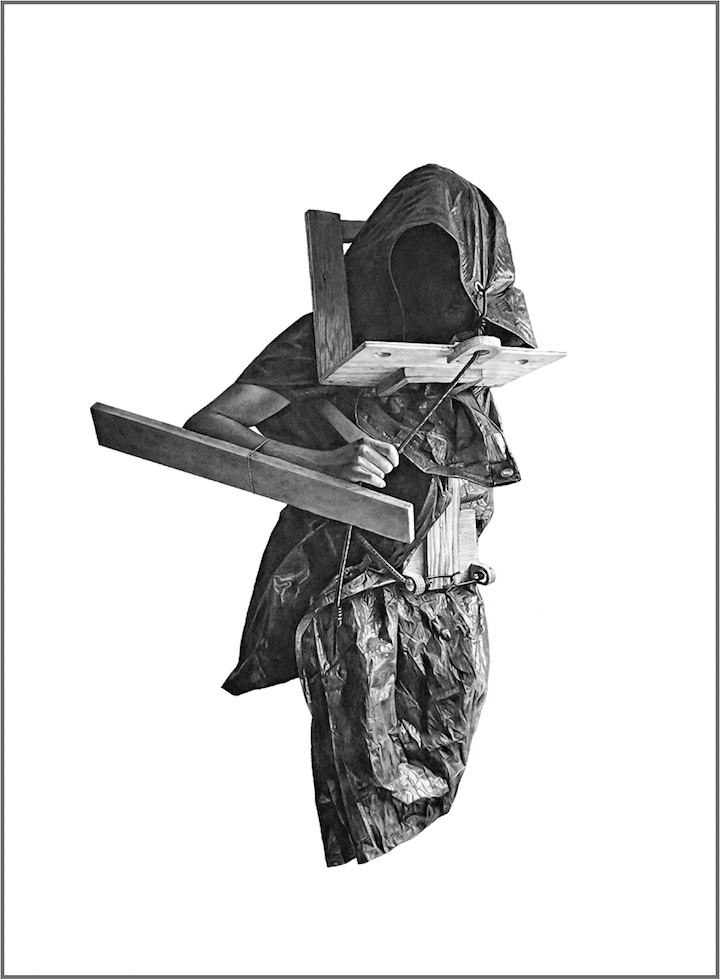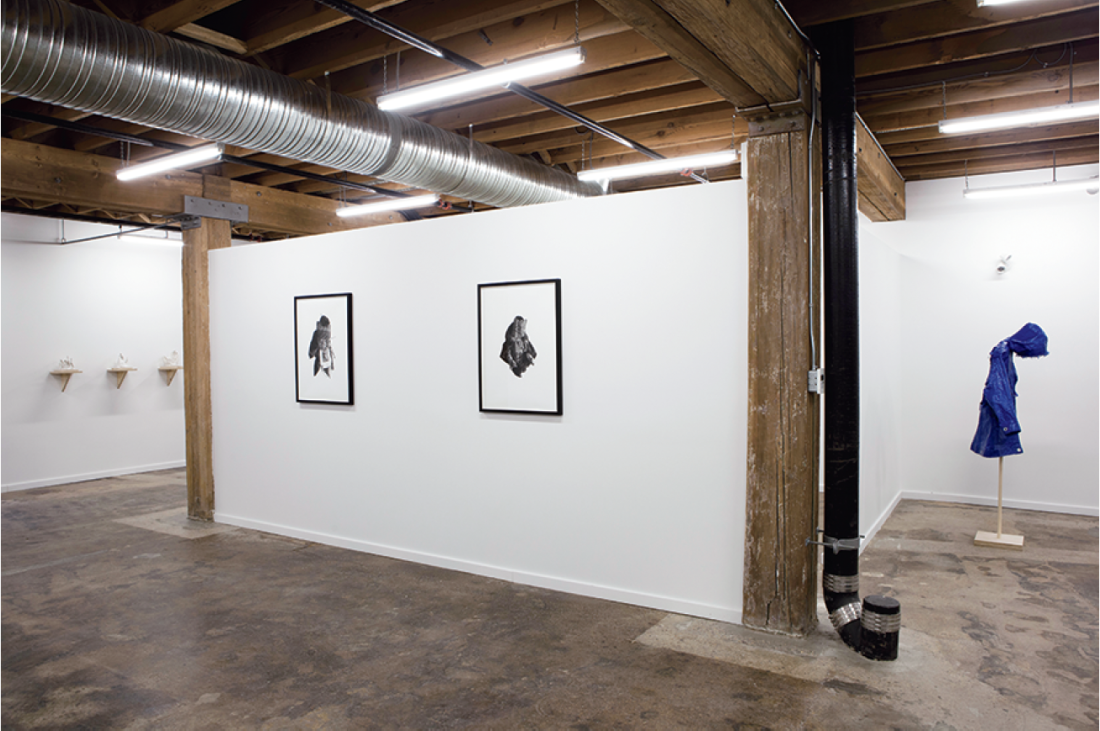Ted Barker
Ted Barker’s first solo exhibition at Lisa Kehler Art + Projects debuts the results of a very productive and experimental period. It seems that his goal is to bestow upon us a sense of wonder by allowing us to bear witness to the care and attention with which he crafts both his work and himself. One could view this exhibition as a sort of creation myth for Mr. Barker, as he presents his dual skills as draughtsman and bricoleur to great effect. The gallery spaces are arranged with four distinct groupings of objects consisting of Conté drawings, watercolours, sculpture and textiles. Sequenced in an almost genteel forensic fashion, the work invites the audience to engage in a search for artistic identity. A word of advice: leave no stone unturned, no detail is too small to be of the utmost importance; things may not appear as they seem.

Ted Barker, Untitled No. 4, 2015, conte on paper, 30 x 22. Courtesy the artist and Lisa Kehler Art + Projects, Winnipeg.
The first pair of objects encountered turn out to be the exhibition’s foil; I resort to the noun related to hunting: the track or scent of a hunted animal. If we follow the scent we see a small watercolour with a central image floated on the wall, without a frame. A realist portrait from the waist up of what we assume is a male (the artist as woodland hermit, I assume). The face is covered with a blue tarpaulin; the torso wears a buckskin bush coat with the hood up. A life-sized replica of this coat, tailored out of blue tarp material, hangs on a dowel like some kind of resigned scarecrow or gracious host, bowing in greeting. With its hood up and face down, arms hanging with complacence or feigned humility—keep your head down, do not make eye contact, keep working, it seems to say. This, of course, runs contrary to the watercolour that challenges your gaze with a one-eyed, hard and creepy stare, edging out from a hole cut in the mask. Many other artist’s self-portraits, Dürer’s from 1500 comes to mind, have imbued their images with grandeur, confidence and potency (creatively and otherwise). Barker’s differs in that he keeps his face hidden, but all the while keeping his hand, the proverbial hand of creation, proudly on display (just like Dürer). Barker places himself centrally on a blank page without any context or background; all the works presented do this, creating a sort of double frame that focuses our gaze and scrutiny upon his well-crafted surfaces.
Next, a room of self-portraits. Again, small realist watercolours are floated on the walls, their edges allowed to cast shadows as the paper slightly ripples towards its edges. Images of sculptures cobbled together out of a mixture of leftover building materials (rigid pink insulation, plywood, particle board, tape) and assorted bric-a-brac such as marbles, twigs, the handle of a broken mug, an ornate inkwell…the strangest being strands of hair, and what looks like a furry snout belonging to a scrap of taxidermy. The gallery’s image list confirms the obvious and not so obvious whimsical stand-ins for Barker’s body parts: ear, eye, hand, heart, mouth, penis and belly button. These depictions of bricolage beg the question “Why not show me the sculptures and not just these laborious reproductions, why the need for such remove?” The portraits show found materials playfully becoming him, while in the room next door it seems like he is attempting to be the materials.

Installation view, Ted Barker, “Detritus,” 2016, Lisa Kehler Art + Projects. Photograph: Karen Asher. Courtesy the artist and Lisa Kehler Art + Projects.
The larger drawings depict a man (the hermit of the woods?) playing a game of dress up, busy making strange in the mode of past Prairie surrealists (both Ivan Eyre and Diana Thorneycroft’s early black and white photos come to mind, or perhaps even Karel Funk). Elaborate yet enigmatic constructions (any practical use seems unclear) made of more tarps, wood, paper and sticks; pieces held together with bungee cords and woodscrews fill up the centres of these poster-sized expanses of white. Virtuosic greyscale drawings in Conté depict lonely, meticulously rendered, fragmented bodies. The exhibition literature notes that Barker is interested in the point of contact between our bodies and the environment, which leads one to the possibility that the making of the costumes might be interpreted as another such point. Though it seems improbable to think of any of these figures being in contact with an environment, since any sense of a world outside the space of the page is absent.
The most effective pieces seem the least controlled. When Barker invites elements of chance into his process the works have more room to breathe, and it feels that we may begin to engage with the distinct textures and surfaces of the microcosmic world that the artist seems to find wondrous. The process of making becomes metaphoric. Here is the place that I can believe and feel the contact that Barker is looking for. Six abstract forms made of plaster each rest on individual plywood shelves. The forms slowly coalesce into pairs of hands. The simplest of casting processes allows for distortions that can be read as changes in emotive pressure, that is, you can see him work. Too often the verisimilitude of the two-dimensional works seems gratuitous, while these sculptures seem real, concrete, grounded. Bits of clay still trapped in the plaster give the objects the character of whalebone or antler; you can imagine him scrubbing them with a toothbrush once freed from their river-mud moulds. If you were prone to extreme reverie you could imagine Daphne’s hands transforming as she slips Apollo’s grasp à la Bernini. This may seem a stretch, but I do think that Barker is, intentionally or not, working through ideas related to transitions, forms and textures going back and forth…trying to create a constant interplay between parts/surfaces.
It is not a stretch for a certain kind of artist to feel that the world is a still life waiting to be drawn, but what is really at stake? Barker is certainly not creating a new optic, let alone a straightforward narrative. He must be after something else, but I wonder if the woodland hermit can decide on what. One hopes this is the early beginning of an authentic search—the traveller is definitely equipped for the journey ahead, but a larger map might be needed.
Or perhaps all my scrutiny is beside the point. The works might be a cautionary fairy tale that could be hummed to the tune of “If you go out in the woods today you’re sure of a big surprise…” ❚
“Detritus” was exhibited at Lisa Kehler Art + Projects, Winnipeg, from January 2 to January 30, 2016.
Craig Love is a Winnipeg-based painter who occasionally writes about art.

